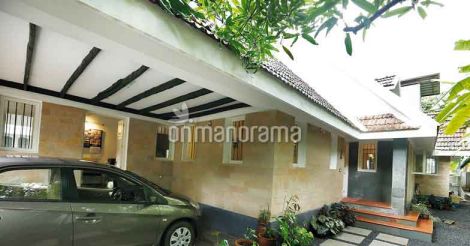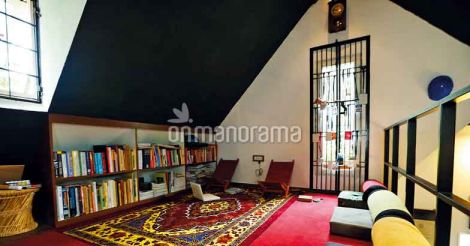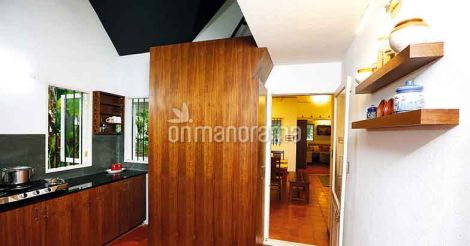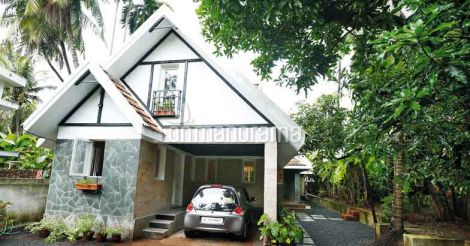Whenever it is an architect building his own dream home, the possibility of experimenting with innovative elements is always there. The owner of the house featured here is an architect and his daughter Urmila happens to be a student of architecture. So what more need we say!
The house is set on a plot that was part of the owner’s share of the ancestral property. Being located at a turning, the house is not easily noticeable from the road. With slanting roofs, the colors used on the exteriors are neutral gray shades. The cladding on the exterior walls has been done using a combination of sandstone and kadappa stone. Plastering has been done only on the top part under the sun shade. There is nothing extraordinary about it at all in the first look. Then what makes this house stand out? Well, the real beauty lies inside, just like how it ought to be!
What looks like a two storey house from the exteriors is actually just a single storey home. There are two doors to get into the house, and one of this leads to the office section which is also a part of the house. The architect’s experiments begin from the first room itself. Let’s look at them one by one;

Experiment 1
None of the interior walls have plastering done. A cement board has been stuck on the walls by leaving a tiny gap. The gap has barely any space for ants even. This board gives the effect of a putty finish. These can be painted on but the family preferred to let it remain white. The main advantage of using cement boards was that the heat in the interiors could be reduced. At Rs 60 per square. feet, it was economical too. When compared to the expenses of plastering all the walls, this is far more economical.
Experiment 2
A slanting roof at 45 degrees has been given for the house. For better utilization of the space on top, the idea of a loft area was experimented with here. This loft area has been done on 3 parts and separate steel ladders have been given to get onto the loft spaces. The loft was made by having plywood laid on steel bars. One of the loft areas comes in daughter Urmila’s room.
To step onto the first landing of the stairs, you need to pull out a chair. But this is no ordinary chair. This is a stair cum ladder multipurpose piece of furniture that can serve as seating as well as a step-up mechanism. The daughter uses this ‘high’ area for her studies. The other loft area is over the office section. This is the owner’s personal zone, where he finds the time to indulge in hobbies like reading, music. There is even a ‘fake balcony’ here like those seen in French style homes. Even though you can’t get out into this balcony, this space can be utilized for gardening. A design touch added in memory of a trip to Paris.
The third loft is on top of the utility area. The steps leading to this space has been given inside the kitchen and it has been smartly hidden away from the visitor’s view too. You can almost be fooled that this is just another kitchen shelf to store condiments. This third loft is mostly used for drying clothes.

Experiment 3
The third experiment had to do with the windows in the house. 1 m long and 50 cm wide single door windows were used throughout the house. In the bedrooms, each wall has two windows of these types. This was much better and useful than giving the usual 4 door windows. Enough air and light get into the room via these windows.
Magic in little details
Terracotta and wood have been used for the flooring. In the living space, tiles were given in the area covered by the sofa, whereas the remaining portion has wooden flooring. As the office section use chairs with wheels, wooden flooring was done away with here.
Lighting is another important factor. Warm tone LED lights bring a special mood inside the house. All the lights and fixtures were purchased from Mumbai, where they were able to source it for much cheaper rates than from Kerala. The switch board design is very attractive. These were fashioned out of the Teak wood waste planks.

The science behind painting the ceilings black was pretty simple. When white reflects light and gives a more spacious feel, black does the opposite and hence the extra height of the ceiling could be seemingly reduced making the interior space appear cozier. Only the ceiling of the car porch was concreted using filler slabs. Over this, cement boards were fixed and paneling done with coconut branch wood. All the wardrobes and cabinets were made of plywood. The wardrobes have a veneer coating. Like in traditional homes, the well has been built adjacent to the house. Through a window in the utility area, you can directly draw water from the well.
An architect’s success lies in the happiness and satisfaction of the family living in the house. His wife Manisha has given him full marks for the design, so there his case rests!
Architect Speaks
After completing his B.Arch from TKM College, Praveenchandra did his higher studies in Historical Conservation. He runs the Kannur based firm - Praveenchandra Associates. He is the former Chairman of the IIA Kannur Chapter.
What is your take on the age old debate of having straight or sloping roofs for Kerala homes?

Kerala is a state that receives rainfall for at least 6 months in a year and for such a climate, sloped roofs are always the better bet. And when the concreting for such roofs is done, the quantity of water used should be reduced. Admixtures could be used for this. It is the lack of skilled workers that make this sloped roof style unpopular. But as an architect, I have to give more priority to the owners’ preferences and hence have to work with flat roofs.
Since it is your own home, there was more scope for experimentation, is it not?
Post Occupancy Evaluation is the next stage. After taking into account the weather variations and noting down the level of heat, moisture etc. inside the house, a detailed study will be undertaken to finally decide if the experiments were successful or not!
Project Facts
Area: 1500 sq. ft.
Architect & Owner: Praveenchandra
Architect
Praveenchandra Associates
Kannur
ppchandra@yahoo.com
























